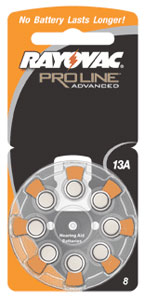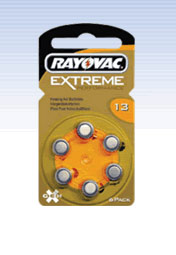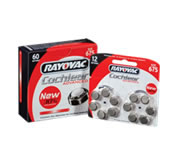Interview with Tom Begley, Division Vice President of Sales, & Dennis Carpenter, Zinc Air Technical Manager, for Rayovac
Topic: Rayovac Extreme Performance Batteries
Paul Dybala: Hello, everyone. This is Paul Dybala with AudiologyOnline, and today I am speaking with two representatives from Rayovac. We have Tom Begley and Dennis Carpenter. I would like to start with each of you describing what you do for Rayovac.
Tom Begley: I am Tom Begley, Division Vice President of Sales for the professional hearing aid group, and I work with hearing health care offices and manufacturers around the world to develop the best battery and battery programs that we can offer.
Dennis Carpenter: I am Dennis Carpenter. I am Zinc Air Technical Manager for Rayovac, and I am involved in the development of the product.
Dybala: I also wanted to add that we've actually had some great contributions to the website by both Tom and Dennis. If you look through our archives, we actually had a great session with Tom, where we did an online seminar, and he literally answered each and every question you could ever want to know about hearing aid batteries. I would direct you to that. Dennis has also been a great contributor, previous "Ask the Expert" questions, etc. So we really have two great resources for this topic.
Before we get into the new Extreme Performance product that Rayovac has just released, Dennis, if you would, please give us a brief battery tutorial about your standard product and then explain how that compares to the new Rayovac Extreme Performance product.
Carpenter: For essentially 95 percent of the market, the standard Rayovac product is what you want to use, because it maximizes life. The general hearing device in the field does not require a lot of power, and our standard battery optimizes performance through time. It works well in different environments, because we have it tuned toward moderate-style performance. This allows one-week to three-weeks of optimum life. The new Extreme Performance product is high-power, but over a shorter period of time, lasting close to a week.

Rayovac Zinc Air Hearing Aid Batteries
Dybala: How do the new batteries compare in terms of operating voltage?
Carpenter: What you have is a higher operating voltage in high-power situations. In a normal hearing aid, the battery will be operating in the 1.25 to 1.3 volt range during its operation. In this type of environment, if you add a wireless device, it requires more power when in the transmit mode. This would lower the voltage of a normal battery in that high-power situation, which could interfere with end-of-life signals and other functions of the hearing instrument.
In this higher-power situation, we need a battery that functions at a higher voltage, above 1.2 volts, which is why we went to an Extreme.
Dybala: How has hearing instrument technology been driving the battery industry forward to develop these higher voltage batteries?

Rayovac Extreme Performance Batteries
Carpenter: Hearing aid manufacturers are creating devices that have Bluetooth functionality. They are able to take a Bluetooth phone, stream it through an intermediate device, and then stream it into the hearing aid. This allows people to essentially listen to their phone or other Bluetooth device through their hearing aid.
Companies are also starting to program the aids through wireless Bluetooth configurations, and a lot of that programming is run by the battery itself. The battery has to be able to handle those higher-drain situations when it is in programming mode or wireless mode.
The Extreme Performance batteries are great for these applications.
Dybala: Are the Extreme Performance batteries available in certain sizes?
Carpenter: Size 13 and 312. These wireless devices generally use size 13 or 312 batteries. Cochlear implants use 675 batteries; therefore, our cochlear implant batteries are available in a 675, and our Extreme Performance batteries are 312s and 13s.

Rayovac Cochlear Advanced 675 Batteries
Begley: Paul, if you take a look at the different devices and the sizes they use, you will see that the device manufacturers are deliberately using smaller and smaller batteries, because people want a smaller device. The old devices that used a 675 will now use a 13. Devices that once used a 13 are now using a 312.
In North America, devices using a 675 battery are the real high-power ones, such as cochlear implant processors. As for other devices that, in the past, would have used a 675, manufacturers have found a way to make them smaller, and the battery needs more power and capacity to respond to that.
Carpenter: Exactly, and the Extreme will work well for these situations. If a standard size 13 battery is not functioning well, you would convert them to the Extreme.
Dybala: What is a good way for clinicians to determine which battery to use?
Carpenter: When you start talking about the power user, what I would usually look for is the output of the aid: how much is the aid delivering once it has been programmed? If you have a hearing aid with a size 13 battery delivering 130 dB output, then you may consider using an Extreme style battery.
The same is true for the hearing aids that are communicating with wireless devices. For instance, Phonak is recommending using a Gen-X style battery, which is our Extreme Performance, for their new device, the Exélia, because of the Bluetooth capability and high functionality.
Generally, what I always suggest is have them try out the regular battery, because the regular battery will give the longest life if you hear well with it. If you have trouble with sound or intermittency, then I would try the Extreme Performance, but I would wait until the patient is dissatisfied with the standard product. I still think that is the best way to go.
Dybala: Okay. Would you ever recommend Extreme batteries for a moderate loss or non-power aids without wireless capabilities?
Carpenter: No, not particularly, because they would probably give somewhat less life.
Dybala: In terms of the patient, what type of counseling is necessary to explain the Extreme Performance batteries? Can they buy these in stores?
Begley: They will need to come back to their hearing care professional. These batteries will not be sold at retail. The professional is the best person to determine the proper use of the battery and matching the battery to the device. Of course, we know that the Gen-X devices out there will work properly with it, because the manufacturer has already done the matching on it, but there are probably a lot of other devices that are in use out there that the new Extreme product will do very well by.
As Dennis said earlier, if the patient or the audiologist is running into a device that is not working quite right, the sound quality is reduced, or it is not lasting as long as it should, then Extreme is an option for them to try.
Dybala: I want to close out today by asking you what you foresee for the future of battery technology. How is Rayovac changing to account for changes in the hearing aid industry?
Carpenter: I think the advent of digital processing led to hearing aids having the capability for more bells and whistles, and when you put more bells and whistles on hearing aids, they require more power. Generally, I think the overall trend is and will be products that will require more power. Managing that power is going to be a challenge for us. Our goal will be to obtain as much power and efficiency out of our products as possible.
Dybala: Great. Well, thank you very much Tom and Dennis for being here today. If anyone needs additional information, go to www.rayovac.com or the Rayovac Web Channel on Audiology Online. I would also encourage everyone to visit Audiology Online. There are several great readings on Rayovac, including an Online Seminar with Tom and an Ask the Expert session with Dennis. Thank you both for your time; we look forward to hearing from you and Rayovac again soon.
More About Rayovac
Starting under the name The French Battery Company, Rayovac was founded in 1906 in Madison, Wisconsin. Over the past 100 years, Rayovac introduced the first wearable vacuum tube hearing aid in 1933, crown cell alkaline batteries for hearing aids in 1949, and silver oxide button cells in 1971. Rayovac now offers a wide variety of batteries for hearing aids and cochlear implants to provide optimal sound quality to people with hearing loss. In addition to hearing aids, Rayovac has a history of innovation in the flashlight and rechargeable battery markets. Rayovac is a dynamic and pioneering company that brings power to many different avenues of life.
Tom Begley: I am Tom Begley, Division Vice President of Sales for the professional hearing aid group, and I work with hearing health care offices and manufacturers around the world to develop the best battery and battery programs that we can offer.
Dennis Carpenter: I am Dennis Carpenter. I am Zinc Air Technical Manager for Rayovac, and I am involved in the development of the product.
Dybala: I also wanted to add that we've actually had some great contributions to the website by both Tom and Dennis. If you look through our archives, we actually had a great session with Tom, where we did an online seminar, and he literally answered each and every question you could ever want to know about hearing aid batteries. I would direct you to that. Dennis has also been a great contributor, previous "Ask the Expert" questions, etc. So we really have two great resources for this topic.
Before we get into the new Extreme Performance product that Rayovac has just released, Dennis, if you would, please give us a brief battery tutorial about your standard product and then explain how that compares to the new Rayovac Extreme Performance product.
Carpenter: For essentially 95 percent of the market, the standard Rayovac product is what you want to use, because it maximizes life. The general hearing device in the field does not require a lot of power, and our standard battery optimizes performance through time. It works well in different environments, because we have it tuned toward moderate-style performance. This allows one-week to three-weeks of optimum life. The new Extreme Performance product is high-power, but over a shorter period of time, lasting close to a week.

Rayovac Zinc Air Hearing Aid Batteries
Dybala: How do the new batteries compare in terms of operating voltage?
Carpenter: What you have is a higher operating voltage in high-power situations. In a normal hearing aid, the battery will be operating in the 1.25 to 1.3 volt range during its operation. In this type of environment, if you add a wireless device, it requires more power when in the transmit mode. This would lower the voltage of a normal battery in that high-power situation, which could interfere with end-of-life signals and other functions of the hearing instrument.
In this higher-power situation, we need a battery that functions at a higher voltage, above 1.2 volts, which is why we went to an Extreme.
Dybala: How has hearing instrument technology been driving the battery industry forward to develop these higher voltage batteries?

Rayovac Extreme Performance Batteries
Carpenter: Hearing aid manufacturers are creating devices that have Bluetooth functionality. They are able to take a Bluetooth phone, stream it through an intermediate device, and then stream it into the hearing aid. This allows people to essentially listen to their phone or other Bluetooth device through their hearing aid.
Companies are also starting to program the aids through wireless Bluetooth configurations, and a lot of that programming is run by the battery itself. The battery has to be able to handle those higher-drain situations when it is in programming mode or wireless mode.
The Extreme Performance batteries are great for these applications.
Dybala: Are the Extreme Performance batteries available in certain sizes?
Carpenter: Size 13 and 312. These wireless devices generally use size 13 or 312 batteries. Cochlear implants use 675 batteries; therefore, our cochlear implant batteries are available in a 675, and our Extreme Performance batteries are 312s and 13s.

Rayovac Cochlear Advanced 675 Batteries
Begley: Paul, if you take a look at the different devices and the sizes they use, you will see that the device manufacturers are deliberately using smaller and smaller batteries, because people want a smaller device. The old devices that used a 675 will now use a 13. Devices that once used a 13 are now using a 312.
In North America, devices using a 675 battery are the real high-power ones, such as cochlear implant processors. As for other devices that, in the past, would have used a 675, manufacturers have found a way to make them smaller, and the battery needs more power and capacity to respond to that.
Carpenter: Exactly, and the Extreme will work well for these situations. If a standard size 13 battery is not functioning well, you would convert them to the Extreme.
Dybala: What is a good way for clinicians to determine which battery to use?
Carpenter: When you start talking about the power user, what I would usually look for is the output of the aid: how much is the aid delivering once it has been programmed? If you have a hearing aid with a size 13 battery delivering 130 dB output, then you may consider using an Extreme style battery.
The same is true for the hearing aids that are communicating with wireless devices. For instance, Phonak is recommending using a Gen-X style battery, which is our Extreme Performance, for their new device, the Exélia, because of the Bluetooth capability and high functionality.
Generally, what I always suggest is have them try out the regular battery, because the regular battery will give the longest life if you hear well with it. If you have trouble with sound or intermittency, then I would try the Extreme Performance, but I would wait until the patient is dissatisfied with the standard product. I still think that is the best way to go.
Dybala: Okay. Would you ever recommend Extreme batteries for a moderate loss or non-power aids without wireless capabilities?
Carpenter: No, not particularly, because they would probably give somewhat less life.
Dybala: In terms of the patient, what type of counseling is necessary to explain the Extreme Performance batteries? Can they buy these in stores?
Begley: They will need to come back to their hearing care professional. These batteries will not be sold at retail. The professional is the best person to determine the proper use of the battery and matching the battery to the device. Of course, we know that the Gen-X devices out there will work properly with it, because the manufacturer has already done the matching on it, but there are probably a lot of other devices that are in use out there that the new Extreme product will do very well by.
As Dennis said earlier, if the patient or the audiologist is running into a device that is not working quite right, the sound quality is reduced, or it is not lasting as long as it should, then Extreme is an option for them to try.
Dybala: I want to close out today by asking you what you foresee for the future of battery technology. How is Rayovac changing to account for changes in the hearing aid industry?
Carpenter: I think the advent of digital processing led to hearing aids having the capability for more bells and whistles, and when you put more bells and whistles on hearing aids, they require more power. Generally, I think the overall trend is and will be products that will require more power. Managing that power is going to be a challenge for us. Our goal will be to obtain as much power and efficiency out of our products as possible.
Dybala: Great. Well, thank you very much Tom and Dennis for being here today. If anyone needs additional information, go to www.rayovac.com or the Rayovac Web Channel on Audiology Online. I would also encourage everyone to visit Audiology Online. There are several great readings on Rayovac, including an Online Seminar with Tom and an Ask the Expert session with Dennis. Thank you both for your time; we look forward to hearing from you and Rayovac again soon.
More About Rayovac
Starting under the name The French Battery Company, Rayovac was founded in 1906 in Madison, Wisconsin. Over the past 100 years, Rayovac introduced the first wearable vacuum tube hearing aid in 1933, crown cell alkaline batteries for hearing aids in 1949, and silver oxide button cells in 1971. Rayovac now offers a wide variety of batteries for hearing aids and cochlear implants to provide optimal sound quality to people with hearing loss. In addition to hearing aids, Rayovac has a history of innovation in the flashlight and rechargeable battery markets. Rayovac is a dynamic and pioneering company that brings power to many different avenues of life.

